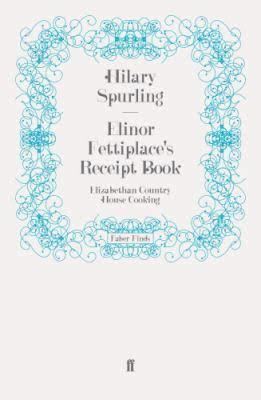8.4 /10 1 Votes8.4
Originally published 1986 Country England | 4.2/5 Goodreads Publication date 1986 [1604] Genre Cookbook | |||||||||||||||||||||||||||||||||
 | ||||||||||||||||||||||||||||||||||
Similar Hilary Spurling books, Cookbooks, Gastronomy books | ||||||||||||||||||||||||||||||||||
Elinor Fettiplace's Receipt Book is a book of recipes compiled in 1604, with additions and marginal notes in several hands. It was first edited and published in 1986 by Hilary Spurling, the wife of a descendant of Fettiplace who had inherited the manuscript. It provides a direct view of Elizabethan cookery in an aristocratic country house, with advice on household management.
Contents
Context
The Fettiplaces were a aristocratic English family of Norman descent, who lived in Berkshire and Oxfordshire.
Elinor, (née Poole, c. 1570–c. 1647) was the wife of Sir Richard Fettiplace, who owned the substantial Appleton Manor in what is now Oxfordshire (formerly in Berkshire). The family had become wealthy from wool. She wrote her 'book of Receipts' in 1604. Apart from Elinor's recipes, the book contains marginal notes and additions written by several different people, indicating that it grew over more than one lifetime. In 1647 Elinor left the manuscript to her niece, Anne Horner, "desyring her to kepe it for my sake".
Publication
The book was first published only in 1986, by The Salamander Press in association with Penguin Books (it was then published in paperback by Penguin in 1987), the manuscript having been inherited by the husband of the editor, Hilary Spurling. The compilation gives an intimate view of Elizabethan era cookery and domestic life in an aristocratic country household.
The book contains over 200 recipes, updated by Spurling. After an introduction on the Fettiplace family, the book is structured into 12 sections for the months of the year. The book ends with a bibliography, notes and index.
Recipes
The book provides recipes for various forms of bread, such as buttered loaves; for apple fritters; preserves and pickles; and a celebration cake for 100 people. New ingredients such as the sweet potato appear. A recipe for dressing a shoulder of mutton calls for the use of the newly-available citrus fruits:
Take a showlder of mutton and being halfe Roasted, Cut it in great slices and save the gravie then take Clarret wine and sinamond & sugar with a little Cloves and mace beatne and the peel of an oringe Cut thin and minced very smale. Put the mutton the gravie and these thinges together and boyle yt between two dishes, wringe the juice of an oringe into yt as yt boyleth, when yt is boyled enough lay the bone of the mutton beinge first Broyled in the dish with it then Cut slices of limonds and lay on the mutton and so serve yt in.
Fettiplace included a recipe for "White Bisket Bread", nowadays called meringue, using one and a half pounds of sugar, a handful of flour, and twelve beaten eggwhites.
Reception
Paula Deitz, writing in the New York Times, quotes Spurling's claim that the book describes "many aspects of Elizabethan household life about which historians had no knowledge."
The Oxford historian A. L. Rowse described the book as "a fascinating find" and wrote that it deserved "to taste of the Victorian Mrs. Beeton's success as a best seller".
The novelist Lawrence Norfolk, writing in The Guardian, described the book as containing "recipes, remedies and preserving methods ... gathered over many years, almost like annotations in a family Bible." He praises Hilary Spurling for testing the recipes, "a heroic undertaking in a modern kitchen", only baulking at Sir Walter Raleigh's "Syrup of Tobacco" which was then widely grown in the West of England. He mentions especially "delicate cat's tongue biscuits", light sauces, and "liaisons whisked up" and describes Fettiplace's recipes as "a sophisticated cuisine but presented as typical of the time."
The historian Elaine Leong describes the effect of the modern title of this and similar books such as "Lady Sedley's Receipt Book" and "Ladie Borlase's Receiptes Booke" as "conjuring up a homey picture of the lady of the manor collecting all sorts of household information as part of her housewifely duties." Leong cautions that while the modern editors of these books "no doubt based their titles on ownership notes inscribed in the manuscripts ... these titles obscure the rich and complex stories of authorship and ownership connected with the texts."
